Korean vs Iranian Community Comparison
COMPARE
Korean
Iranian
Social Comparison
Social Comparison
Koreans
Iranians
6,713
SOCIAL INDEX
64.6/ 100
SOCIAL RATING
147th/ 347
SOCIAL RANK
9,682
SOCIAL INDEX
94.3/ 100
SOCIAL RATING
8th/ 347
SOCIAL RANK
Iranian Integration in Korean Communities
The statistical analysis conducted on geographies consisting of 312,105,078 people shows a moderate negative correlation between the proportion of Iranians within Korean communities in the United States with a correlation coefficient (R) of -0.436. On average, for every 1% (one percent) increase in Koreans within a typical geography, there is a decrease of 0.008% in Iranians. To illustrate, in a geography comprising of 100,000 individuals, a rise of 1,000 Koreans corresponds to a decrease of 8.1 Iranians.
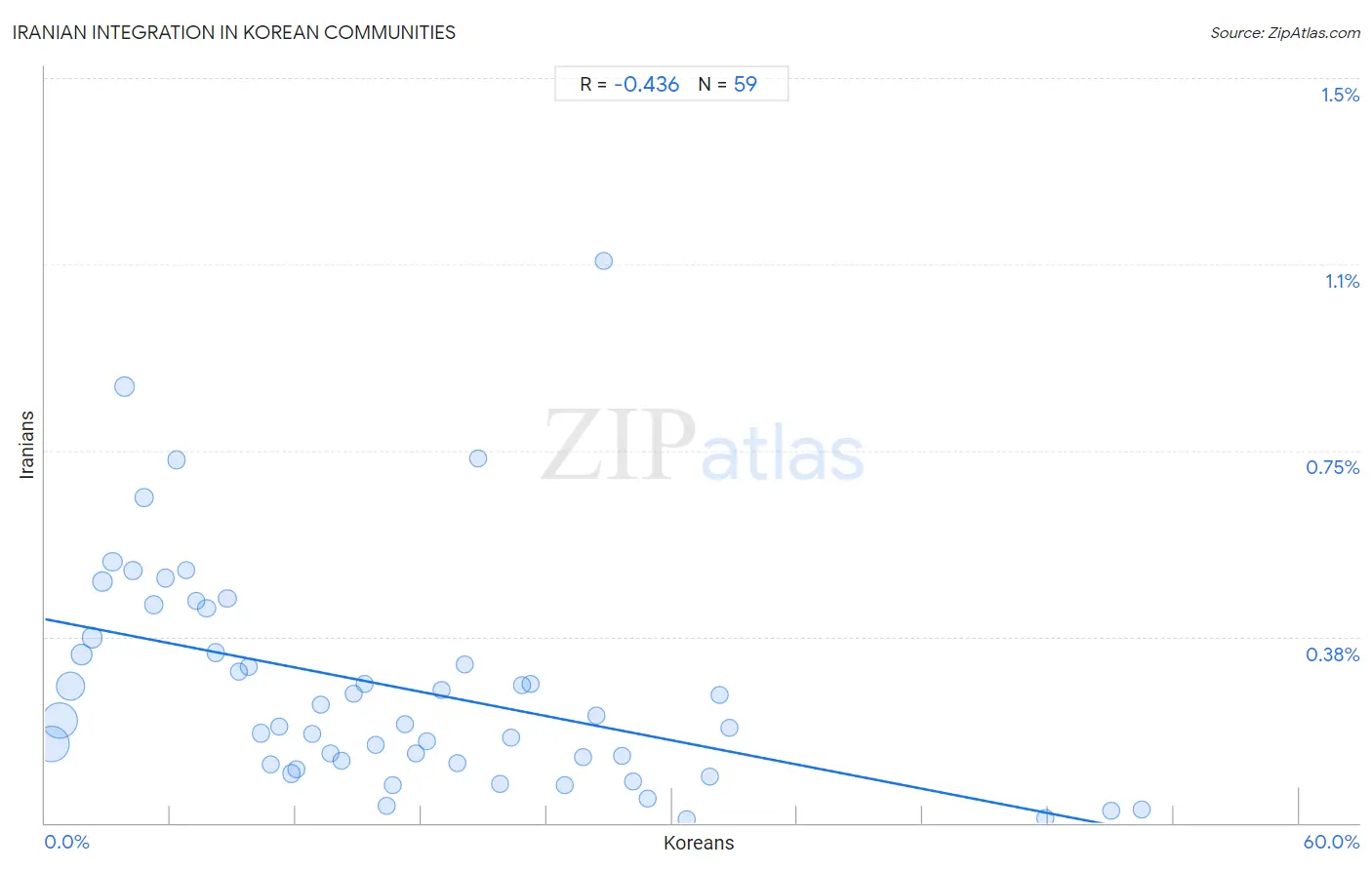
Korean vs Iranian Income
When considering income, the most significant differences between Korean and Iranian communities in the United States are seen in per capita income ($44,522 compared to $58,786, a difference of 32.0%), median male earnings ($56,672 compared to $70,648, a difference of 24.7%), and median family income ($110,103 compared to $133,839, a difference of 21.6%). Conversely, both communities are more comparable in terms of householder income under 25 years ($57,730 compared to $55,548, a difference of 3.9%), householder income over 65 years ($67,472 compared to $77,429, a difference of 14.8%), and median female earnings ($41,276 compared to $47,421, a difference of 14.9%).

| Income Metric | Korean | Iranian |
| Per Capita Income | Good $44,522 | Exceptional $58,786 |
| Median Family Income | Exceptional $110,103 | Exceptional $133,839 |
| Median Household Income | Exceptional $95,018 | Exceptional $109,835 |
| Median Earnings | Exceptional $48,727 | Exceptional $58,474 |
| Median Male Earnings | Excellent $56,672 | Exceptional $70,648 |
| Median Female Earnings | Exceptional $41,276 | Exceptional $47,421 |
| Householder Age | Under 25 years | Exceptional $57,730 | Exceptional $55,548 |
| Householder Age | 25 - 44 years | Exceptional $103,824 | Exceptional $120,292 |
| Householder Age | 45 - 64 years | Exceptional $110,334 | Exceptional $129,350 |
| Householder Age | Over 65 years | Exceptional $67,472 | Exceptional $77,429 |
| Wage/Income Gap | Good 25.4% | Tragic 29.7% |
Korean vs Iranian Poverty
When considering poverty, the most significant differences between Korean and Iranian communities in the United States are seen in receiving food stamps (10.4% compared to 7.9%, a difference of 31.1%), female poverty among 18-24 year olds (16.9% compared to 20.1%, a difference of 18.5%), and child poverty under the age of 16 (13.9% compared to 12.2%, a difference of 13.4%). Conversely, both communities are more comparable in terms of seniors poverty over the age of 75 (11.5% compared to 11.5%, a difference of 0.24%), male poverty (9.9% compared to 9.8%, a difference of 0.87%), and poverty (10.9% compared to 10.7%, a difference of 1.3%).
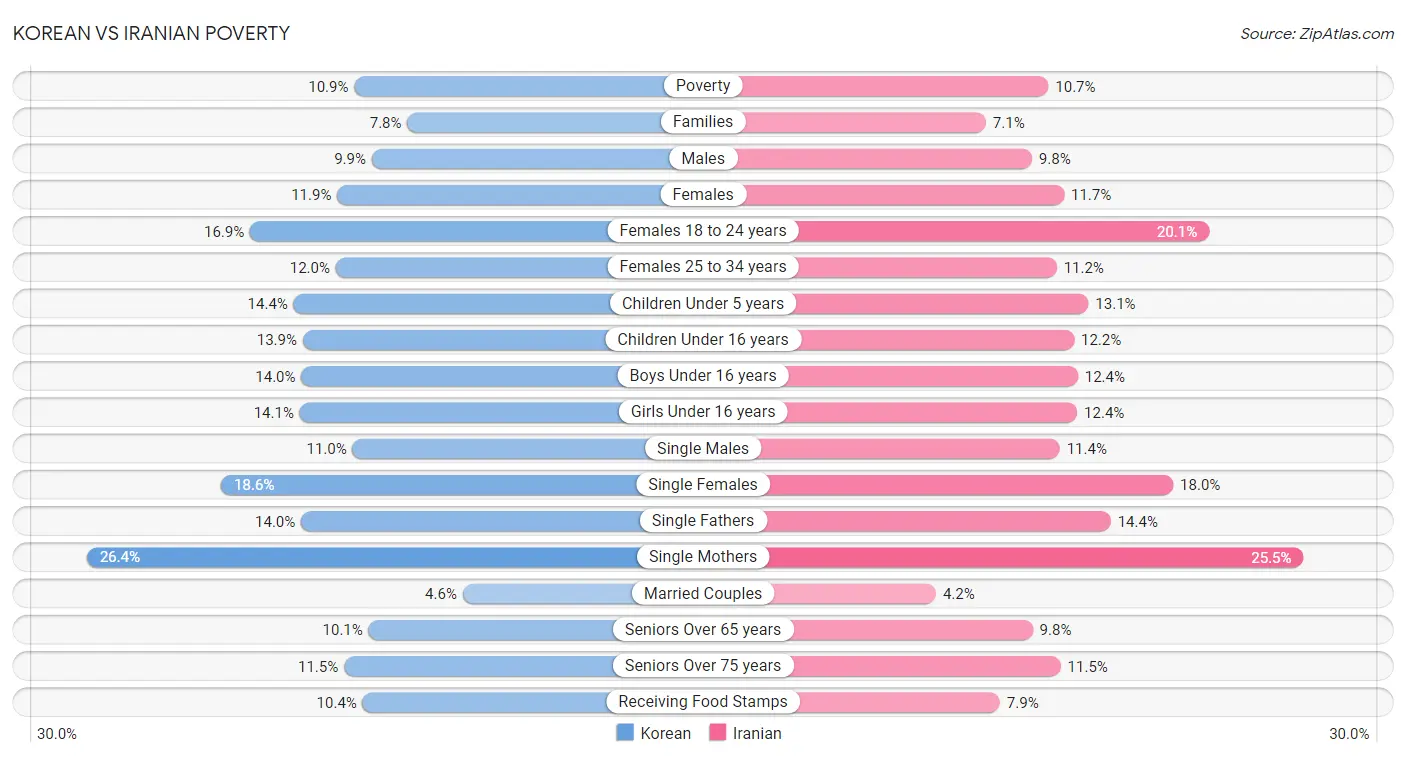
| Poverty Metric | Korean | Iranian |
| Poverty | Exceptional 10.9% | Exceptional 10.7% |
| Families | Exceptional 7.8% | Exceptional 7.1% |
| Males | Exceptional 9.9% | Exceptional 9.8% |
| Females | Exceptional 11.9% | Exceptional 11.7% |
| Females 18 to 24 years | Exceptional 16.9% | Average 20.1% |
| Females 25 to 34 years | Exceptional 12.0% | Exceptional 11.2% |
| Children Under 5 years | Exceptional 14.4% | Exceptional 13.1% |
| Children Under 16 years | Exceptional 13.9% | Exceptional 12.2% |
| Boys Under 16 years | Exceptional 14.0% | Exceptional 12.4% |
| Girls Under 16 years | Exceptional 14.1% | Exceptional 12.4% |
| Single Males | Exceptional 11.0% | Exceptional 11.4% |
| Single Females | Exceptional 18.6% | Exceptional 18.0% |
| Single Fathers | Exceptional 14.0% | Exceptional 14.4% |
| Single Mothers | Exceptional 26.4% | Exceptional 25.5% |
| Married Couples | Exceptional 4.6% | Exceptional 4.2% |
| Seniors Over 65 years | Exceptional 10.1% | Exceptional 9.8% |
| Seniors Over 75 years | Exceptional 11.5% | Exceptional 11.5% |
| Receiving Food Stamps | Exceptional 10.4% | Exceptional 7.9% |
Korean vs Iranian Unemployment
When considering unemployment, the most significant differences between Korean and Iranian communities in the United States are seen in unemployment among seniors over 75 years (8.9% compared to 7.9%, a difference of 12.6%), unemployment among women with children under 6 years (7.5% compared to 6.7%, a difference of 10.5%), and unemployment among ages 30 to 34 years (5.6% compared to 5.2%, a difference of 8.3%). Conversely, both communities are more comparable in terms of unemployment among ages 20 to 24 years (10.3% compared to 10.2%, a difference of 0.82%), unemployment among ages 60 to 64 years (4.9% compared to 5.0%, a difference of 1.0%), and unemployment among ages 65 to 74 years (5.3% compared to 5.2%, a difference of 1.2%).
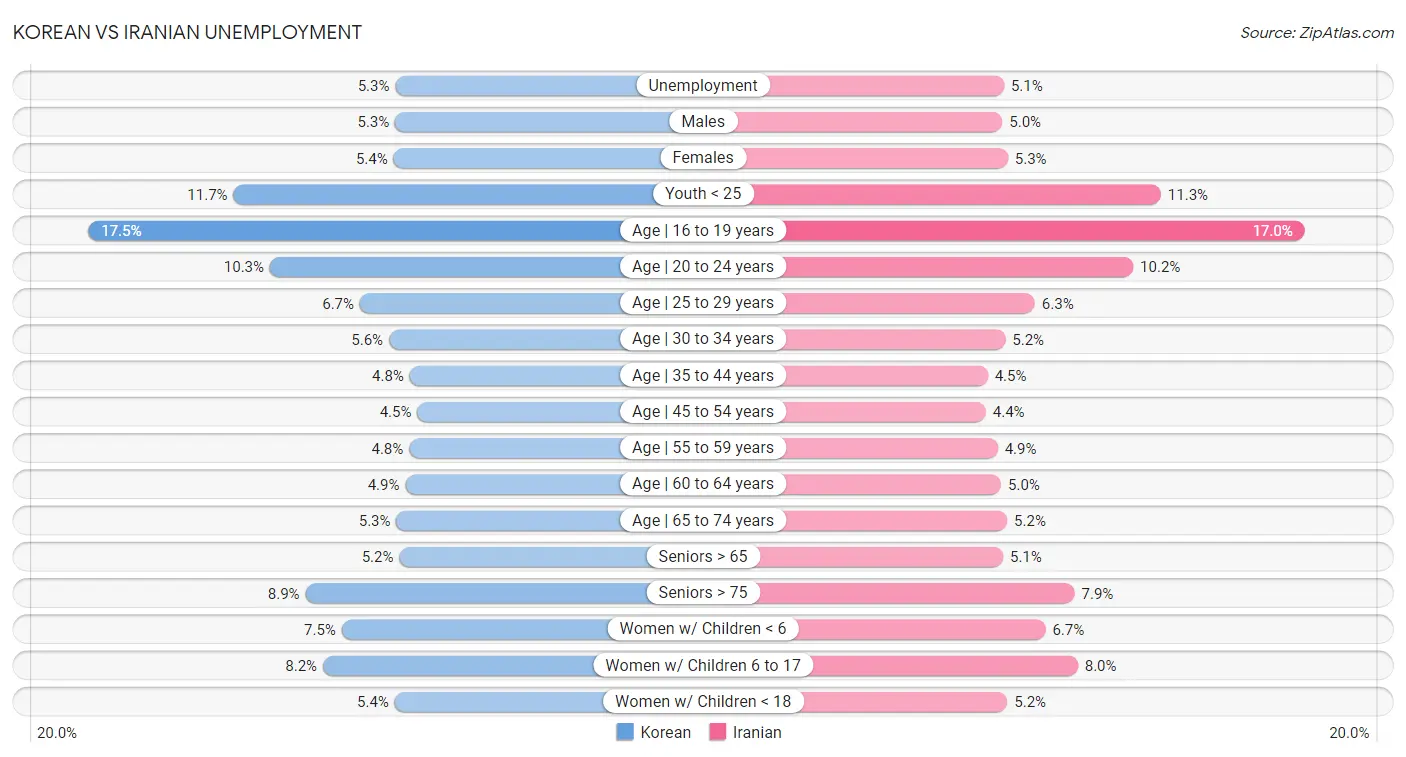
| Unemployment Metric | Korean | Iranian |
| Unemployment | Fair 5.3% | Excellent 5.1% |
| Males | Fair 5.3% | Exceptional 5.0% |
| Females | Poor 5.4% | Average 5.3% |
| Youth < 25 | Fair 11.7% | Exceptional 11.3% |
| Age | 16 to 19 years | Good 17.5% | Exceptional 17.0% |
| Age | 20 to 24 years | Average 10.3% | Good 10.2% |
| Age | 25 to 29 years | Fair 6.7% | Exceptional 6.3% |
| Age | 30 to 34 years | Fair 5.6% | Exceptional 5.2% |
| Age | 35 to 44 years | Fair 4.8% | Exceptional 4.5% |
| Age | 45 to 54 years | Good 4.5% | Exceptional 4.4% |
| Age | 55 to 59 years | Good 4.8% | Fair 4.9% |
| Age | 60 to 64 years | Poor 4.9% | Tragic 5.0% |
| Age | 65 to 74 years | Excellent 5.3% | Exceptional 5.2% |
| Seniors > 65 | Fair 5.2% | Excellent 5.1% |
| Seniors > 75 | Fair 8.9% | Exceptional 7.9% |
| Women w/ Children < 6 | Excellent 7.5% | Exceptional 6.7% |
| Women w/ Children 6 to 17 | Exceptional 8.2% | Exceptional 8.0% |
| Women w/ Children < 18 | Good 5.4% | Excellent 5.2% |
Korean vs Iranian Labor Participation
When considering labor participation, the most significant differences between Korean and Iranian communities in the United States are seen in in labor force | age 16-19 (35.7% compared to 33.0%, a difference of 8.2%), in labor force | age 20-24 (75.4% compared to 72.6%, a difference of 4.0%), and in labor force | age 30-34 (84.5% compared to 85.4%, a difference of 1.0%). Conversely, both communities are more comparable in terms of in labor force | age 35-44 (84.3% compared to 84.5%, a difference of 0.22%), in labor force | age 20-64 (79.8% compared to 80.0%, a difference of 0.29%), and in labor force | age 45-54 (82.9% compared to 83.2%, a difference of 0.36%).

| Labor Participation Metric | Korean | Iranian |
| In Labor Force | Age > 16 | Exceptional 65.7% | Exceptional 66.0% |
| In Labor Force | Age 20-64 | Good 79.8% | Exceptional 80.0% |
| In Labor Force | Age 16-19 | Poor 35.7% | Tragic 33.0% |
| In Labor Force | Age 20-24 | Good 75.4% | Tragic 72.6% |
| In Labor Force | Age 25-29 | Tragic 84.2% | Good 84.8% |
| In Labor Force | Age 30-34 | Fair 84.5% | Exceptional 85.4% |
| In Labor Force | Age 35-44 | Fair 84.3% | Good 84.5% |
| In Labor Force | Age 45-54 | Good 82.9% | Exceptional 83.2% |
Korean vs Iranian Family Structure
When considering family structure, the most significant differences between Korean and Iranian communities in the United States are seen in single father households (2.4% compared to 1.9%, a difference of 24.2%), single mother households (6.0% compared to 5.0%, a difference of 21.1%), and births to unmarried women (30.1% compared to 25.3%, a difference of 19.0%). Conversely, both communities are more comparable in terms of currently married (47.9% compared to 48.6%, a difference of 1.4%), married-couple households (49.7% compared to 49.0%, a difference of 1.6%), and divorced or separated (11.3% compared to 10.8%, a difference of 5.0%).

| Family Structure Metric | Korean | Iranian |
| Family Households | Exceptional 68.3% | Poor 63.9% |
| Family Households with Children | Exceptional 29.2% | Excellent 27.7% |
| Married-couple Households | Exceptional 49.7% | Exceptional 49.0% |
| Average Family Size | Exceptional 3.36 | Tragic 3.18 |
| Single Father Households | Fair 2.4% | Exceptional 1.9% |
| Single Mother Households | Excellent 6.0% | Exceptional 5.0% |
| Currently Married | Exceptional 47.9% | Exceptional 48.6% |
| Divorced or Separated | Exceptional 11.3% | Exceptional 10.8% |
| Births to Unmarried Women | Excellent 30.1% | Exceptional 25.3% |
Korean vs Iranian Vehicle Availability
When considering vehicle availability, the most significant differences between Korean and Iranian communities in the United States are seen in 4 or more vehicles in household (8.6% compared to 6.5%, a difference of 33.8%), 3 or more vehicles in household (24.1% compared to 20.1%, a difference of 19.7%), and no vehicles in household (8.0% compared to 8.6%, a difference of 7.0%). Conversely, both communities are more comparable in terms of 1 or more vehicles in household (92.1% compared to 91.5%, a difference of 0.63%), 2 or more vehicles in household (61.0% compared to 58.1%, a difference of 5.1%), and no vehicles in household (8.0% compared to 8.6%, a difference of 7.0%).

| Vehicle Availability Metric | Korean | Iranian |
| No Vehicles Available | Exceptional 8.0% | Exceptional 8.6% |
| 1+ Vehicles Available | Exceptional 92.1% | Exceptional 91.5% |
| 2+ Vehicles Available | Exceptional 61.0% | Exceptional 58.1% |
| 3+ Vehicles Available | Exceptional 24.1% | Excellent 20.1% |
| 4+ Vehicles Available | Exceptional 8.6% | Good 6.5% |
Korean vs Iranian Education Level
When considering education level, the most significant differences between Korean and Iranian communities in the United States are seen in professional degree (4.1% compared to 7.6%, a difference of 87.4%), doctorate degree (1.7% compared to 3.1%, a difference of 83.3%), and master's degree (14.0% compared to 22.3%, a difference of 59.1%). Conversely, both communities are more comparable in terms of nursery school (97.7% compared to 98.2%, a difference of 0.56%), kindergarten (97.6% compared to 98.2%, a difference of 0.57%), and 1st grade (97.6% compared to 98.2%, a difference of 0.57%).
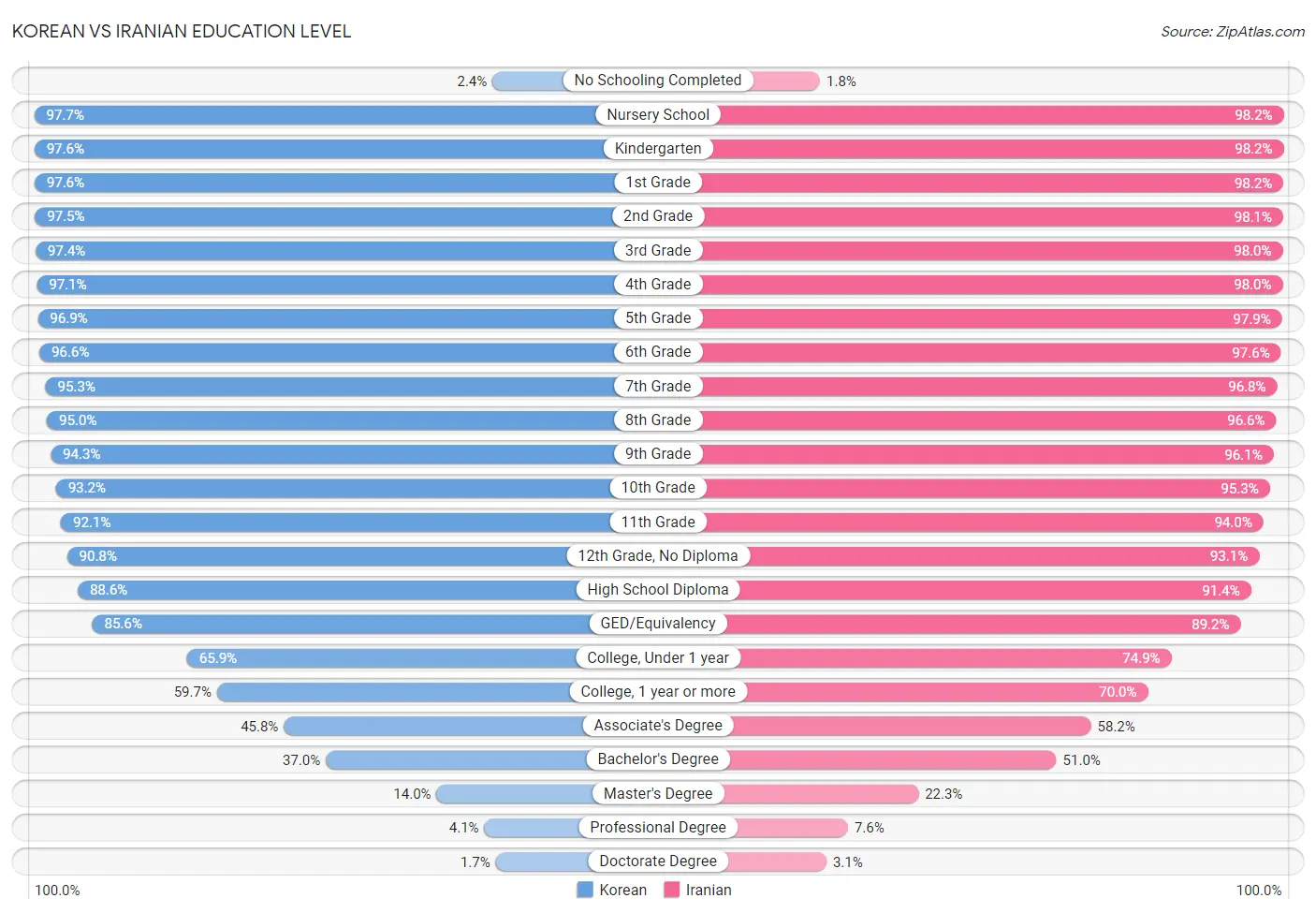
| Education Level Metric | Korean | Iranian |
| No Schooling Completed | Tragic 2.4% | Exceptional 1.8% |
| Nursery School | Tragic 97.7% | Exceptional 98.2% |
| Kindergarten | Tragic 97.6% | Exceptional 98.2% |
| 1st Grade | Tragic 97.6% | Exceptional 98.2% |
| 2nd Grade | Tragic 97.5% | Exceptional 98.1% |
| 3rd Grade | Tragic 97.4% | Exceptional 98.0% |
| 4th Grade | Tragic 97.1% | Exceptional 98.0% |
| 5th Grade | Tragic 96.9% | Exceptional 97.9% |
| 6th Grade | Tragic 96.6% | Exceptional 97.6% |
| 7th Grade | Tragic 95.3% | Exceptional 96.8% |
| 8th Grade | Tragic 95.0% | Exceptional 96.6% |
| 9th Grade | Tragic 94.3% | Exceptional 96.1% |
| 10th Grade | Tragic 93.2% | Exceptional 95.3% |
| 11th Grade | Poor 92.1% | Exceptional 94.0% |
| 12th Grade, No Diploma | Fair 90.8% | Exceptional 93.1% |
| High School Diploma | Poor 88.6% | Exceptional 91.4% |
| GED/Equivalency | Average 85.6% | Exceptional 89.2% |
| College, Under 1 year | Good 65.9% | Exceptional 74.9% |
| College, 1 year or more | Average 59.7% | Exceptional 70.0% |
| Associate's Degree | Fair 45.8% | Exceptional 58.2% |
| Bachelor's Degree | Fair 37.0% | Exceptional 51.0% |
| Master's Degree | Poor 14.0% | Exceptional 22.3% |
| Professional Degree | Poor 4.1% | Exceptional 7.6% |
| Doctorate Degree | Poor 1.7% | Exceptional 3.1% |
Korean vs Iranian Disability
When considering disability, the most significant differences between Korean and Iranian communities in the United States are seen in disability age 35 to 64 (10.5% compared to 8.7%, a difference of 20.9%), disability age 65 to 74 (23.1% compared to 19.9%, a difference of 16.1%), and vision disability (2.1% compared to 1.8%, a difference of 15.9%). Conversely, both communities are more comparable in terms of cognitive disability (16.8% compared to 16.5%, a difference of 2.1%), disability age over 75 (48.6% compared to 45.9%, a difference of 5.9%), and disability age 18 to 34 (6.3% compared to 5.8%, a difference of 8.9%).
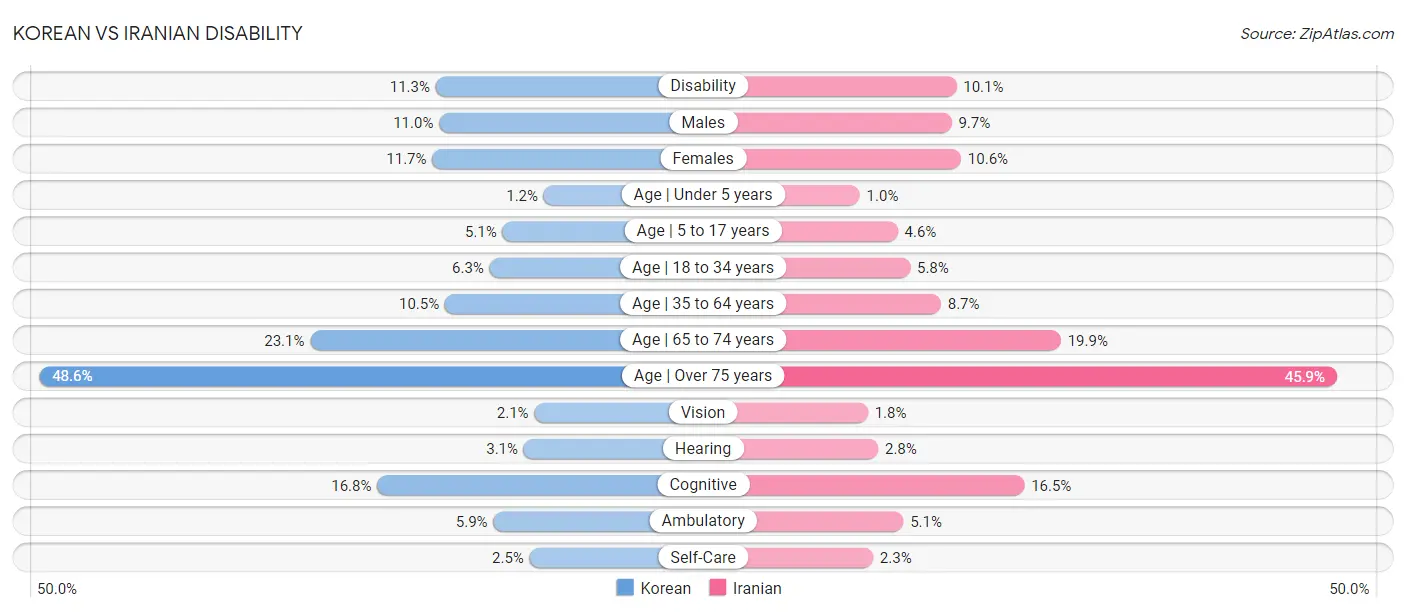
| Disability Metric | Korean | Iranian |
| Disability | Exceptional 11.3% | Exceptional 10.1% |
| Males | Good 11.0% | Exceptional 9.7% |
| Females | Exceptional 11.7% | Exceptional 10.6% |
| Age | Under 5 years | Excellent 1.2% | Exceptional 1.0% |
| Age | 5 to 17 years | Exceptional 5.1% | Exceptional 4.6% |
| Age | 18 to 34 years | Exceptional 6.3% | Exceptional 5.8% |
| Age | 35 to 64 years | Exceptional 10.5% | Exceptional 8.7% |
| Age | 65 to 74 years | Good 23.1% | Exceptional 19.9% |
| Age | Over 75 years | Tragic 48.6% | Exceptional 45.9% |
| Vision | Exceptional 2.1% | Exceptional 1.8% |
| Hearing | Fair 3.1% | Exceptional 2.8% |
| Cognitive | Exceptional 16.8% | Exceptional 16.5% |
| Ambulatory | Exceptional 5.9% | Exceptional 5.1% |
| Self-Care | Poor 2.5% | Exceptional 2.3% |